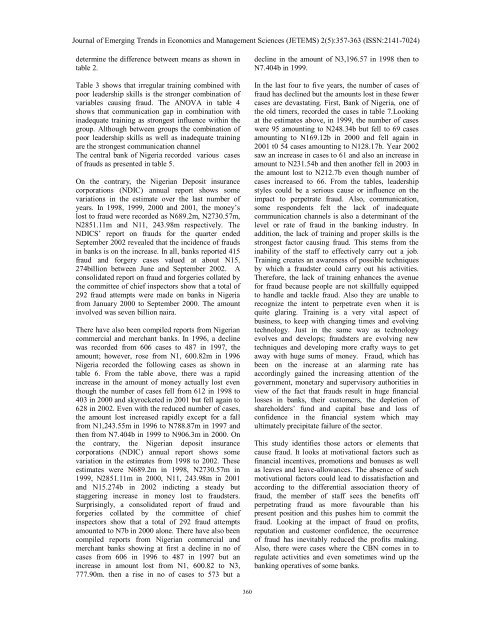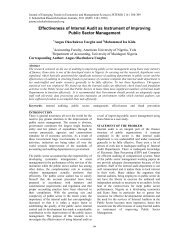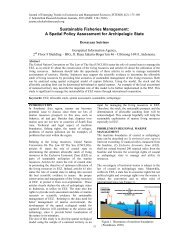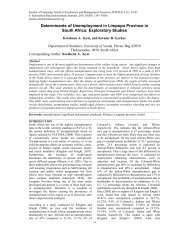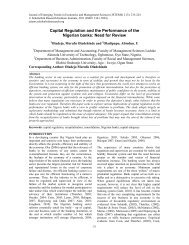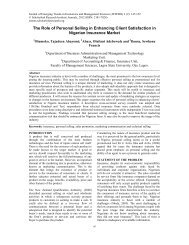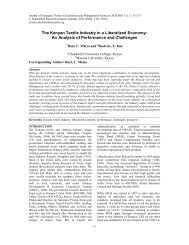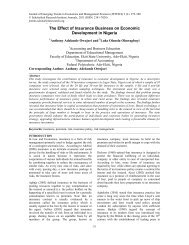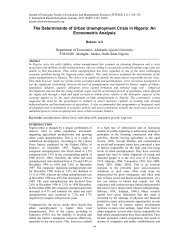Fraud as a Negative Catalyst in the Nigerian Banking Industry
Fraud as a Negative Catalyst in the Nigerian Banking Industry
Fraud as a Negative Catalyst in the Nigerian Banking Industry
Create successful ePaper yourself
Turn your PDF publications into a flip-book with our unique Google optimized e-Paper software.
Journal of Emerg<strong>in</strong>g Trends <strong>in</strong> Economics and Management Sciences (JETEMS) 2(5):357-363 (ISSN:2141-7024)determ<strong>in</strong>e <strong>the</strong> difference between means <strong>as</strong> shown <strong>in</strong>table 2.Table 3 shows that irregular tra<strong>in</strong><strong>in</strong>g comb<strong>in</strong>ed withpoor leadership skills is <strong>the</strong> stronger comb<strong>in</strong>ation ofvariables caus<strong>in</strong>g fraud. The ANOVA <strong>in</strong> table 4shows that communication gap <strong>in</strong> comb<strong>in</strong>ation with<strong>in</strong>adequate tra<strong>in</strong><strong>in</strong>g <strong>as</strong> strongest <strong>in</strong>fluence with<strong>in</strong> <strong>the</strong>group. Although between groups <strong>the</strong> comb<strong>in</strong>ation ofpoor leadership skills <strong>as</strong> well <strong>as</strong> <strong>in</strong>adequate tra<strong>in</strong><strong>in</strong>gare <strong>the</strong> strongest communication channelThe central bank of Nigeria recorded various c<strong>as</strong>esof frauds <strong>as</strong> presented <strong>in</strong> table 5.On <strong>the</strong> contrary, <strong>the</strong> <strong>Nigerian</strong> Deposit <strong>in</strong>surancecorporations (NDIC) annual report shows somevariations <strong>in</strong> <strong>the</strong> estimate over <strong>the</strong> l<strong>as</strong>t number ofyears. In 1998, 1999, 2000 and 2001, <strong>the</strong> money’slost to fraud were recorded <strong>as</strong> N689.2m, N2730.57m,N2851.11m and N11, 243.98m respectively. TheNDICS’ report on frauds for <strong>the</strong> quarter endedSeptember 2002 revealed that <strong>the</strong> <strong>in</strong>cidence of frauds<strong>in</strong> banks is on <strong>the</strong> <strong>in</strong>cre<strong>as</strong>e. In all, banks reported 415fraud and forgery c<strong>as</strong>es valued at about N15,274billion between June and September 2002. Aconsolidated report on fraud and forgeries collated by<strong>the</strong> committee of chief <strong>in</strong>spectors show that a total of292 fraud attempts were made on banks <strong>in</strong> Nigeriafrom January 2000 to September 2000. The amount<strong>in</strong>volved w<strong>as</strong> seven billion naira.There have also been compiled reports from <strong>Nigerian</strong>commercial and merchant banks. In 1996, a decl<strong>in</strong>ew<strong>as</strong> recorded from 606 c<strong>as</strong>es to 487 <strong>in</strong> 1997, <strong>the</strong>amount; however, rose from N1, 600.82m <strong>in</strong> 1996Nigeria recorded <strong>the</strong> follow<strong>in</strong>g c<strong>as</strong>es <strong>as</strong> shown <strong>in</strong>table 6. From <strong>the</strong> table above, <strong>the</strong>re w<strong>as</strong> a rapid<strong>in</strong>cre<strong>as</strong>e <strong>in</strong> <strong>the</strong> amount of money actually lost eventhough <strong>the</strong> number of c<strong>as</strong>es fell from 612 <strong>in</strong> 1998 to403 <strong>in</strong> 2000 and skyrocketed <strong>in</strong> 2001 but fell aga<strong>in</strong> to628 <strong>in</strong> 2002. Even with <strong>the</strong> reduced number of c<strong>as</strong>es,<strong>the</strong> amount lost <strong>in</strong>cre<strong>as</strong>ed rapidly except for a fallfrom N1,243.55m <strong>in</strong> 1996 to N788.87m <strong>in</strong> 1997 and<strong>the</strong>n from N7.404b <strong>in</strong> 1999 to N906.3m <strong>in</strong> 2000. On<strong>the</strong> contrary, <strong>the</strong> <strong>Nigerian</strong> deposit <strong>in</strong>surancecorporations (NDIC) annual report shows somevariation <strong>in</strong> <strong>the</strong> estimates from 1998 to 2002. Theseestimates were N689.2m <strong>in</strong> 1998, N2730.57m <strong>in</strong>1999, N2851.11m <strong>in</strong> 2000, N11, 243.98m <strong>in</strong> 2001and N15.274b <strong>in</strong> 2002 <strong>in</strong>dict<strong>in</strong>g a steady butstagger<strong>in</strong>g <strong>in</strong>cre<strong>as</strong>e <strong>in</strong> money lost to fraudsters.Surpris<strong>in</strong>gly, a consolidated report of fraud andforgeries collated by <strong>the</strong> committee of chief<strong>in</strong>spectors show that a total of 292 fraud attemptsamounted to N7b <strong>in</strong> 2000 alone. There have also beencompiled reports from <strong>Nigerian</strong> commercial andmerchant banks show<strong>in</strong>g at first a decl<strong>in</strong>e <strong>in</strong> no ofc<strong>as</strong>es from 606 <strong>in</strong> 1996 to 487 <strong>in</strong> 1997 but an<strong>in</strong>cre<strong>as</strong>e <strong>in</strong> amount lost from N1, 600.82 to N3,777.90m. <strong>the</strong>n a rise <strong>in</strong> no of c<strong>as</strong>es to 573 but adecl<strong>in</strong>e <strong>in</strong> <strong>the</strong> amount of N3,196.57 <strong>in</strong> 1998 <strong>the</strong>n toN7.404b <strong>in</strong> 1999.In <strong>the</strong> l<strong>as</strong>t four to five years, <strong>the</strong> number of c<strong>as</strong>es offraud h<strong>as</strong> decl<strong>in</strong>ed but <strong>the</strong> amounts lost <strong>in</strong> <strong>the</strong>se fewerc<strong>as</strong>es are dev<strong>as</strong>tat<strong>in</strong>g. First, Bank of Nigeria, one of<strong>the</strong> old timers, recorded <strong>the</strong> c<strong>as</strong>es <strong>in</strong> table 7.Look<strong>in</strong>gat <strong>the</strong> estimates above, <strong>in</strong> 1999, <strong>the</strong> number of c<strong>as</strong>eswere 95 amount<strong>in</strong>g to N248.34b but fell to 69 c<strong>as</strong>esamount<strong>in</strong>g to N169.12b <strong>in</strong> 2000 and fell aga<strong>in</strong> <strong>in</strong>2001 t0 54 c<strong>as</strong>es amount<strong>in</strong>g to N128.17b. Year 2002saw an <strong>in</strong>cre<strong>as</strong>e <strong>in</strong> c<strong>as</strong>es to 61 and also an <strong>in</strong>cre<strong>as</strong>e <strong>in</strong>amount to N231.54b and <strong>the</strong>n ano<strong>the</strong>r fell <strong>in</strong> 2003 <strong>in</strong><strong>the</strong> amount lost to N212.7b even though number ofc<strong>as</strong>es <strong>in</strong>cre<strong>as</strong>ed to 66. From <strong>the</strong> tables, leadershipstyles could be a serious cause or <strong>in</strong>fluence on <strong>the</strong>impact to perpetrate fraud. Also, communication,some respondents felt <strong>the</strong> lack of <strong>in</strong>adequatecommunication channels is also a determ<strong>in</strong>ant of <strong>the</strong>level or rate of fraud <strong>in</strong> <strong>the</strong> bank<strong>in</strong>g <strong>in</strong>dustry. Inaddition, <strong>the</strong> lack of tra<strong>in</strong><strong>in</strong>g and proper skills is <strong>the</strong>strongest factor caus<strong>in</strong>g fraud. This stems from <strong>the</strong><strong>in</strong>ability of <strong>the</strong> staff to effectively carry out a job.Tra<strong>in</strong><strong>in</strong>g creates an awareness of possible techniquesby which a fraudster could carry out his activities.Therefore, <strong>the</strong> lack of tra<strong>in</strong><strong>in</strong>g enhances <strong>the</strong> avenuefor fraud because people are not skillfully equippedto handle and tackle fraud. Also <strong>the</strong>y are unable torecognize <strong>the</strong> <strong>in</strong>tent to perpetrate even when it isquite glar<strong>in</strong>g. Tra<strong>in</strong><strong>in</strong>g is a very vital <strong>as</strong>pect ofbus<strong>in</strong>ess, to keep with chang<strong>in</strong>g times and evolv<strong>in</strong>gtechnology. Just <strong>in</strong> <strong>the</strong> same way <strong>as</strong> technologyevolves and develops; fraudsters are evolv<strong>in</strong>g newtechniques and develop<strong>in</strong>g more crafty ways to getaway with huge sums of money. <strong>Fraud</strong>, which h<strong>as</strong>been on <strong>the</strong> <strong>in</strong>cre<strong>as</strong>e at an alarm<strong>in</strong>g rate h<strong>as</strong>accord<strong>in</strong>gly ga<strong>in</strong>ed <strong>the</strong> <strong>in</strong>cre<strong>as</strong><strong>in</strong>g attention of <strong>the</strong>government, monetary and supervisory authorities <strong>in</strong>view of <strong>the</strong> fact that frauds result <strong>in</strong> huge f<strong>in</strong>anciallosses <strong>in</strong> banks, <strong>the</strong>ir customers, <strong>the</strong> depletion ofshareholders’ fund and capital b<strong>as</strong>e and loss ofconfidence <strong>in</strong> <strong>the</strong> f<strong>in</strong>ancial system which mayultimately precipitate failure of <strong>the</strong> sector.This study identifies those actors or elements thatcause fraud. It looks at motivational factors such <strong>as</strong>f<strong>in</strong>ancial <strong>in</strong>centives, promotions and bonuses <strong>as</strong> well<strong>as</strong> leaves and leave-allowances. The absence of suchmotivational factors could lead to dissatisfaction andaccord<strong>in</strong>g to <strong>the</strong> differential <strong>as</strong>sociation <strong>the</strong>ory offraud, <strong>the</strong> member of staff sees <strong>the</strong> benefits offperpetrat<strong>in</strong>g fraud <strong>as</strong> more favourable than hispresent position and this pushes him to commit <strong>the</strong>fraud. Look<strong>in</strong>g at <strong>the</strong> impact of fraud on profits,reputation and customer confidence, <strong>the</strong> occurrenceof fraud h<strong>as</strong> <strong>in</strong>evitably reduced <strong>the</strong> profits mak<strong>in</strong>g.Also, <strong>the</strong>re were c<strong>as</strong>es where <strong>the</strong> CBN comes <strong>in</strong> toregulate activities and even sometimes w<strong>in</strong>d up <strong>the</strong>bank<strong>in</strong>g operatives of some banks.360


